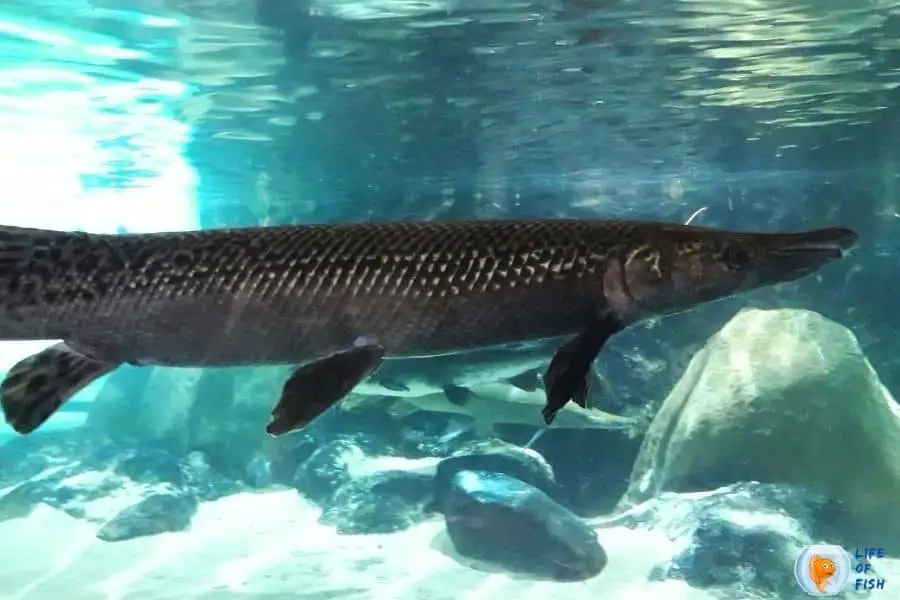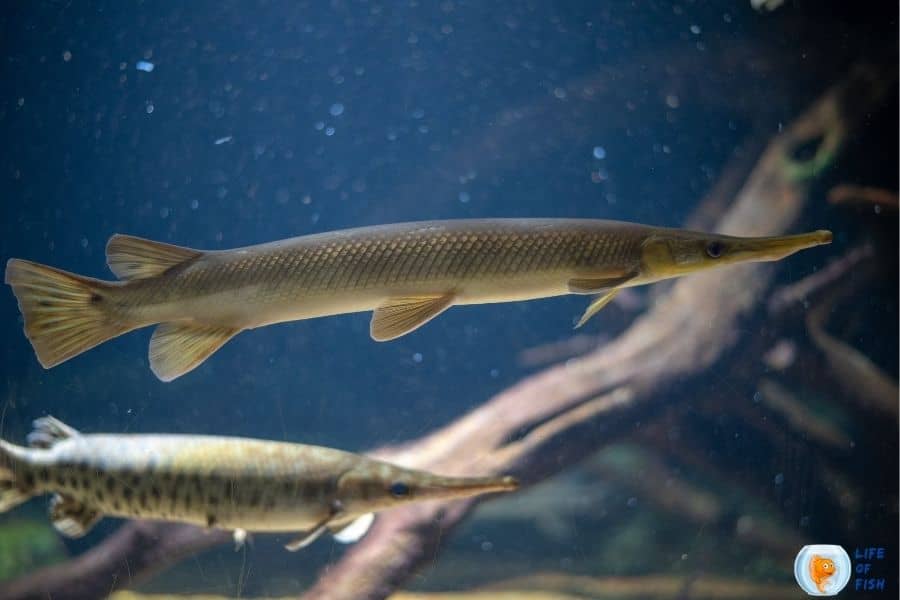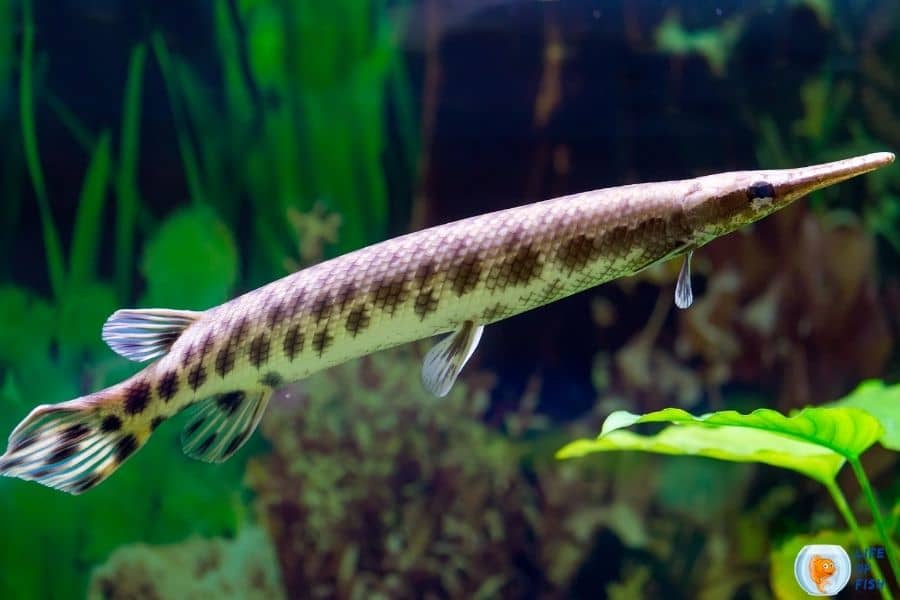It’s obvious that everyone now wonders, “where do alligator gar live?”. You can find the answer to this question along with several other details about these magnificent fish.
Alligator gars are unique fish species that resemble dinosaurs. They are huge and have Alligator-like heads, which makes them terrifying to look at.
Alligator gars are one of the largest living freshwater species in the world. Because of their prehistoric look, we call them “living fossils.”

Alligator gar Description
Jump To
- 1 Alligator gar Description
- 2 Natural habitats of Alligator gar
- 3 How big does alligator gar grow?
- 4 What does alligator gar eat?
- 5 How long do alligator gars live?
- 6 Preferable water condition
- 7 Preferable environmental condition
- 8 What states have alligator gar?
- 9 Where does alligator gar live in lakes?
- 10 Recently asked question
- 11 Conclusion
Alligator gars (Atractosteus spatula) are top predators of the food chain.
They have bodies that resemble prehistoric dinosaurs or Alligators, making them one of the terrifying creatures in rivers and lakes.
Their native habitats are mostly swamps, lakes, and rivers in the southern United States.
The alligator gar is a giant fish species that can live for about 50 years or more in the wild. It has a lengthy lifespan because it takes a lot of time to reach sexual maturity.
Alligator gars are predatory fish, and they can eat almost anything that comes in their way, including smaller gar species, turtles, snakes, and even deer fawns.
They have a flat snout and long teeth. They are often misidentified as prehistoric Dinosaurs.
Alligator gar is one of the most important fish species, which helps to keep the ecosystem in balance.
Locals people call this fish “Fishzilla” because it is top predator fish that can grow very large.
This giant predatory fish has earned a lot of respect from hunters and anglers, and it’s still highly sought after.
They are famous trophy fish species in the southern states of America, where local people greatly fear them.
The alligator gar has an amazing ability to survive in harsh conditions, and its range was once spread over 20 US states, but now it spread only in about 10-12 states.
There is a high demand for gar oil in various traditional Asian medicines, and Asians believes that oil has some medicinal properties.
This has turned into a serious threat, as it drives the wild populations near extinction.
Natural habitats of Alligator gar
Alligator gar’s natural habitats are mostly rivers, lakes, and swamps. They live in the Southern United States, commonly in Texas and Louisiana.
You can find them in deep waters that have a soft mud or clay bottom.
Alligator gars can also live in brackish waters of estuaries, bayous, and bays. You can occasionally see them in the Gulf Coast of Texas, Tamaulipas, northern Veracruz, and Mexico.
Once they were inhabited in Nebraska, Ohio, central Kansas, Iowa, and west-central Illinois, they are now listed extirpated mostly due to culling.
These fish species also reside in protected areas such as Atchafalaya River Basin’s federal lands, Caddo Lake National Wildlife Refuge, Guadalupe River, Sabine National Wildlife Refuge, Sam Houston Jones State Park, and Toledo Bend Reservoir.
In these natural habitats, alligator gar enjoys calm waters with abundant vegetation of aquatic plants.
These fish feed on other fish species such as garfish, turtles, or alligators by using their long bodies to walk along the bottom then suddenly attacking their prey. They are the natural predators of turtles, snakes, and other large fish.
How big does alligator gar grow?
The maximum length that an alligator gar can reach is around 10 feet (3 meters) long. The heaviest ever recorded was 350 pounds (160 kilograms).
What does alligator gar eat?
Alligator gars are carnivores and top-level predators in the food chain. They are feed on other fish species, turtles, snakes, and mammals.
Apart from that alligator gar is also fond of crustaceans such as crabs, mollusks, and shrimp.
They hunt like an alligator by using their bodies to move along the vegetation of bottom water; then, they suddenly attack their prey.
They are opportunistic night predators. Their diet is dependent primarily on their hunting experience.
Aquatic vegetation is important to alligator gar. If there’s an abundance of aquatic plants, this fish can grow faster and healthier because they provide shelter for small fish that can be hunted easily by larger predators like alligator gar.
However, alligator gars prey on other fish like garfish and turtles. They are ambush predators that use their long bodies to walk along the bottom and suddenly attack their prey.

How long do alligator gars live?
The average lifespan of alligator gar is 50 to 70 years. However, some Alligator gars live more than 95 years old.
Preferable water condition
Alligator gars can tolerate various water conditions, from fresh water, brackish water and salt waters. They are the fish species that can live in low-oxygen waters, which is why they thrive in swamps and bayous.
Alligator gars also prefer soft clays or mud as their bottom water habitat because it’s easier for them to walk along the bottom.
However, these species prefer sluggish pools and backwaters of rivers, swamps, lakes, and bayous. In the open waters, they don’t usually swim in groups due to their solitary nature.
Alligator gar lives in the Southern United States and prefers calm waters with abundant vegetation of aquatic plants. They tend to stay along brackish water’s edge.
Alligator gars prefer cold water conditions but can tolerate temperatures from 11 to 28C. The preferred pH level is about 6 to 8pH, and the preferred water hardness is about 90 – 447 ppm.
Preferable environmental condition
Alligator gars can survive in warm and cold climates. You can find Alligator gars in the Southern United States, East to Texas and north to Nebraska, Ohio, Kansas, Iowa, Illinois.
Their preferred area is the Gulf Coast of Texas (including Galveston Bay), Veracruz (Mexico), and Tamaulipas (Mexico).
These fish tend to spawn in warmer environment conditions and live in abundance in the wild in colder times.
Alligator gars live in the lower reaches of rivers, bayous, swamps, and lakes. They don’t usually swim in groups because they prefer a solitary life.
Even though they can live under various environmental conditions, Alligator gars are an endangered species and protected under various acts.
Any activity that harms these fish species is punishable by law.
What states have alligator gar?
Alligator gars are common in Texas, Louisiana, Arkansas, and Oklahoma. They are also abundant in various states like:
- Missouri (Mississippi River and Illinois River and major tributaries)
- Tennessee (Mississippi River basin, Illinois River, and the Gulf of Mexico )
- Illinois (lower Kaskaskia River, Horseshoe Lake at Horseshoe Lake State Park and Powerton Lake)
- Indiana (White River- rare)
- Kentucky (Ohio, Mississippi, lower Cumberland, and Tennessee River )
- Michigan (Lake Michigan)
- Oklahoma (Texoma Lake, the Red River, and its tributaries)
- Arkansas (Mississippi, Arkansas, White, Ouachita, and Red Rivers )
- Louisiana (very common in lakes, reservoirs, and rivers)
- Texas (ubiquitous in lakes, reservoirs, and rivers)
- Mississippi (Mississippi lake, Mississippi river)
- Alabama (most coastal estuaries, rivers, and large streams)
- Florida (Apalachicola River)
- Georgia (Lake Allatoona, Alapaha River)
Alligator gar population reduce from many parts of their original range due to several factors such as illegal fishing or competition with other commercial fish species.
In the below regions, Alligator gars are already listed as extirpated.
- Kansas
- Nebraska
- Ohio
- Iowa
- west-central Illinois
Where does alligator gar live in lakes?
Alligator gars live in warm, shallow, and densely vegetated freshwater habitats in Lakes. They have a primitive swim bladder which makes them rise and fall directly with the buoyancy of water.
This swim bladder also allows them to breathe directly from the air, which is why they can live out of water for an extended period and survive in low oxygenated waters.
However alligator gars prefer calm waters with low-strength currents where they can easily move along the bottom.

Recently asked question
Is an alligator gar a dinosaur?
Alligator gar is technically not a dinosaur. But, their prehistoric relatives date back to about 215 million years ago.
Paleontologists have found fossils of Alligator gar ancestors lived in Dinasaur age in Permian Deposits.
Alligator Gars are not dinosaurs, but they go back about 215 million years in the fossil record.
Alligator gar is one of the most primitive fish in the world today, and they resemble their ancestors who lived in the Dinosaur age.
Further this is why many people misidentify them as Dinosaurs. Many people refer to Alligator gar as “Living fossils” and “primitive fishes” because they have retained some of the morphological characteristics of their ancestors.
Is alligator gar going extinct?
Alligator gars are not extinct, but they are extirpated in some regions. They are rare and endangered because of habitat loss and over-fishing.
Alligator gars are very popular in the southern United States because they provide a lot of food.
Also, their body parts (primarily their swim bladders) are used in various traditional Asian medicines.
In some places, Alligator gars were fished for their meat and skin before they became highly protected in the 1970s.
Studies show that these fish are susceptible to overfishing in Alabama, Mississippi, and Luciana states.
It’s rare in Missouri, threatened in Illinois, endangered in Arkansas, and on the verge of extinction in Tennessee, where it’s now listed as an endangered species.
How long can a gar live?
Alligator gar can live for about 50 years or more in the wild, but their life span is probably not much longer because of over-fishing, habitat loss, and changes to their native ecosystems.
According to one report, Alligator gars life expectancy can go beyond 95 years.
How fast can an alligator gar grow?
They may grow about 3 to 4 feet in length within three years. However, their growth rate slows down with age and size.
For example, it may take about 15 years for a gar to reach about 5 to 6 feet long and another 25 years to grow 1 to 2 feet more.
How did alligator gar get its name?
The broad snout and the long, sharp teeth of alligator gar resemble the head of an American Alligator. Therefore, it has been named as “Alligator gar.”
What is the oldest alligator gar?
The oldest Alligator gar recorded in history was from Mississippi River. It was 8 feet 5 1/2 inches long, an estimated 50 to 70 years old.
Kenny Williams of Vicksburg, Mississippi, inadvertently caught an Alligator gar on Lake Chotard while fishing for Buffalo fish on February 14, 2011.
The fish was weighed 327 lb (148 kg), and it had a circumference of 47 in (120 cm). This fish was later included in the world record list as the largest alligator gar ever caught.
Conclusion
Conclusion paragraph: Alligator gars are one of the oldest species on earth, dating back to at least the Cretaceous period.
They can live in almost any water, including freshwater, brackish water, and saltwater habitats.
However, these fish mostly live in rivers, lakes, and swamps in the Southern United States. You may also find them in brackish waters of estuaries, bayous, and bays.
Read more Alligator Gar Size | 9 Interesting Facts You Must Know |
Read more What does Alligator Gar Eat? | 14 Crazy Facts About Alligator Gars |
